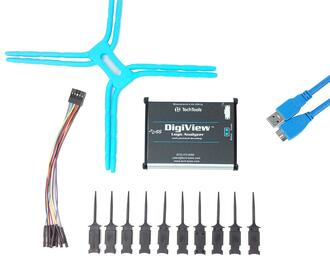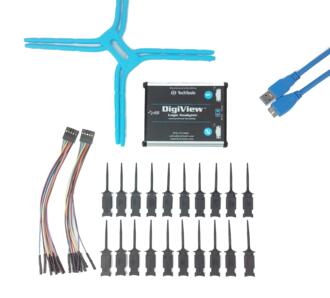Theory of Operation
All logic analyzers perform the same basic function: sample digital data at a specific rate and display the results. However, there are huge differences in implementation and functionality. The following describes DigiView's implementation and general operation.Basic Operation
This is the fundamental operation we expect out of test equipment we call 'Logic Analyzers.' DigiViews and traditional bench-top devices work this way. Some hobby-grade devices skip some (or even most) of this functionality. We consider this to be the minimum, base-line functionality.- Target signals are compared to a configurable threshold voltage. Voltages above the threshold are forced to a logic high level; lower voltages are forced to a logic low level.
- The comparator output is sampled at a specific rate
- The data samples are written to a buffer (very high speed memory) in the logic analyzer
- When the buffer fills to the 'prefill' level, it begins looking for a trigger event.
- While waiting for the trigger, the buffer operates in 'ring buffer' mode, meaning that when the buffer hits full, it wraps around and starts writing at the beginning again, replacing the oldest data with the newest. This ensures that it always contains the most recent samples in memory...no matter how long it runs.
- When a trigger is detected, the current buffer write-location is noted (as the trigger point).
- 'Buffer-size - Prefill' additional data samples are stored in the buffer and then the capture is stopped.
- The captured data is displayed for analysis.
DigiView Enhancements
DigiView extends traditional Logic Analyzers with the following enhanced or new functions.- Compression
Increases storage duration AND allows us to always run at maximum sample-rate, giving best resolution. Eliminates capture-time vs resolution trade-offs. Always maximizes both! - Dual Storage Modes
- Store-and-Forward
Basic operation stores the compressed data in a large, local hi-speed ring buffer, then transfers the buffer to the PC when the capture is complete. This guarantees full bandwidth operation. - Streaming
Uploads data to the PC during capture. Hardware based compression and a very large FIFO enables extended capture time in all but the most demanding situations.
- Store-and-Forward
- Hybrid Storage Controller
Automatically reconfigures the hardware to select the best storage mode without loosing any capture data or missing a trigger... even in mid-capture. Maximizes capture time without compromising performance or reliability. Never over-runs, misses triggers, or suggests you 'reduce sample rate' or 'try again'. - Leverages your Existing PC
Uses PC's processing power and versitile I/O for display and analysis. Save costs, enhances portability and increases performance. NOTE: Reliable captures do NOT depend on the PC performance; all real-time capture functions are done in hardware. When streaming, the PC does NOT process the data or write to disk; it just stores it in memory.
DigiView Block Diagram

Block Descriptions
Front End
- Compensated for improved signal integrity
- Robust design. Test equipment should tolerate the occasional static zap or being connected to a power rail or to a defective target.
- Protected against over and under voltages and over current.
- Ground leads protected against against over-current from connecting to ± 12V
- Extra anti-static protection
Threshold
- Adjustable over a ± 4V range in ~50mv steps
- Typically set to mid-signal voltage swing
- Can be tweaked up/down to improve margins.
Sampler
- Always samples the data at 1Gsps.
- A configurable glitch filter can reduce storage waste and display distractions.
- A down-sampler reduces the sample rate to 1/2 or 1/4 for for wider channel modes.
Trigger
- Extensive trigger capabilities
- Implemented in hardware; Operates at full bandwidth, in real-time
- Reliable - impossible to miss a trigger.
Compressor
- Accepts data at the SAMPLE rate, outputs data proportional to the (much lower) DATA rate
- Increases capture time
- Permits maximum sample rate and best resolution at all times
- Dynamically adapts to the current data conditions as well as the upcoming data characteristics to achieve the best compression.
Buffer
- Guaranteed full capture bandwidth
- Configured as a large FIFO at start of capture
- The large FIFO, combined with compression enables ultra reliable streaming up to 100M transitions per sec. at full sample-rate/resolution.
- Tolerates long bursts of ultra-fast data and/or PC 'hiccups'/pauses.
- When the data rate exceeds 100M transitions per sec., capture data are prioritized and uploads are reduced
- If the fast data continues too long (several million transitions), the FIFO will fill up
- If the FIFO fills and a trigger has NOT been seen yet, the buffer will automatically switch to ring-buffer mode and the DigiVIew will operate in store-and-forward mode. This ensure guaranteed operation and that a capture will never give up before seeing a trigger.
- If the FIFO fills and a trigger HAS been seen, the capture will halt and the FIFO contents will be uploaded, adding to the existing post-fill data.
USB Interface
- USB 3.1 - Super Speed
- Compatible with USB 2 - High Speed
- Reliable hardware captures are not dependant on the USB speed. The only effect of using USB 2 is a reduction in the maximum data rate that can take advantage of the extra capture time afforded by streaming.
PC
- Using the PC for display, analysis and user I/O saves costs, enhances portability, and increases performance.
- The PC has a lot more processing power and superior human interfaces than we could build into the analyzer at a reasonable price.
- No real-time processing is done on the PC. Reliable hardware captures are not dependant on the PC's performance.
Need more information?
Browse the left-hand menu, or choose one of of these shortcuts:Ready to hunt down bugs?
Choose your debug partner.
DV509

9 channels
1Gsps@4ch
500Msps@9ch
500Msps@9ch
Typical capture1:
100M Transitions, > 1B samples
4M-18M Protocol Characters/Bytes
100M Transitions, > 1B samples
4M-18M Protocol Characters/Bytes
$599
DV518

18 channels
1Gsps@4ch, 500Msps@9ch
250Msps@18ch
250Msps@18ch
Typical capture1:
100M Transitions, > 1B samples
4M-18M Protocol Characters/Bytes
100M Transitions, > 1B samples
4M-18M Protocol Characters/Bytes
$749
All DigiViews include: • All available Protocol Plugins • USB and Data Cables • Full compliment of Micro-grabber clips • Plugin Developers' Kit
1 Try our interactive chart for more capture details.